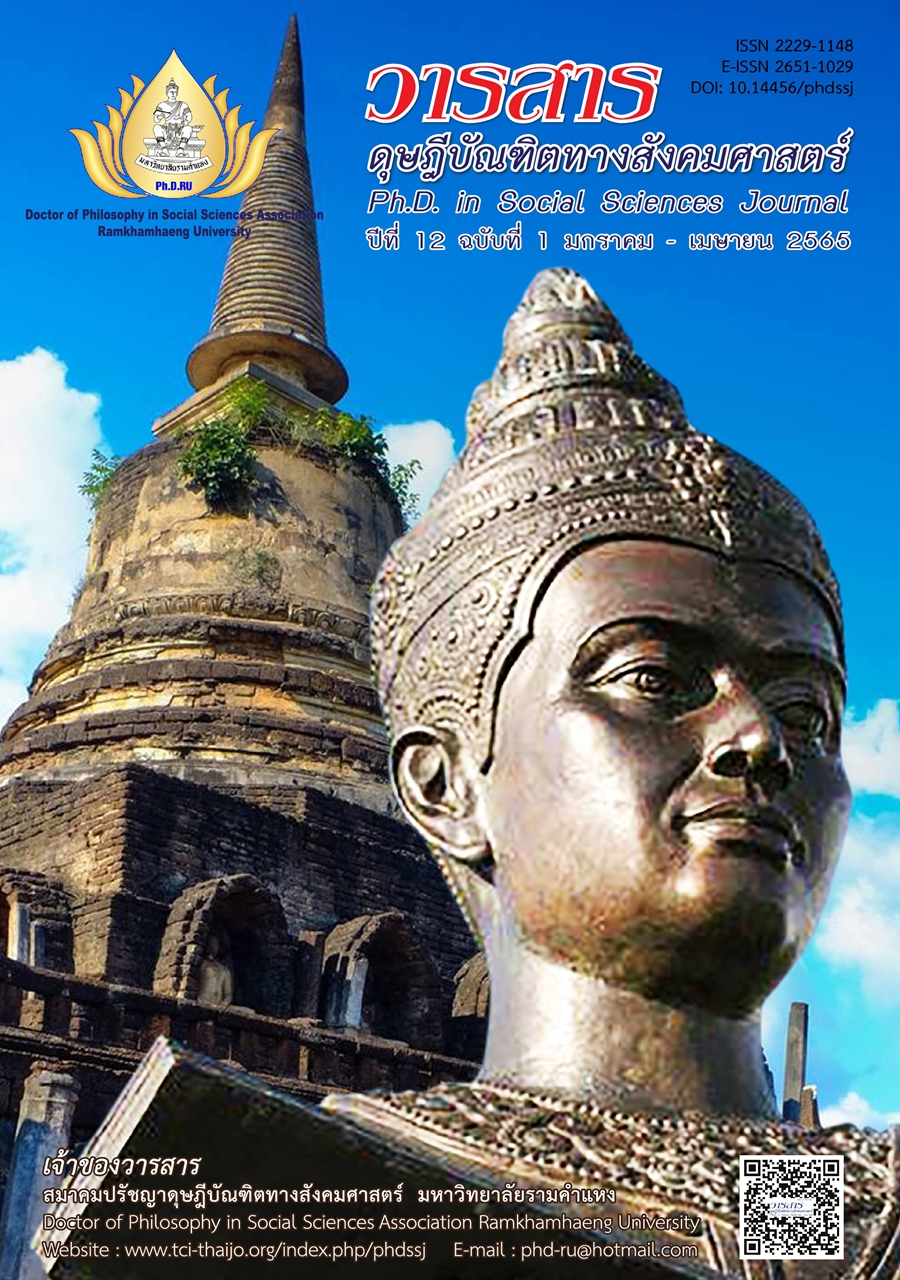ปัจจัยที่มีอิทธิพลต่อการมีส่วนร่วมทางการเมืองของผู้สูงอายุ ในเขตกรุงเทพมหานครและปริมณฑล
Main Article Content
บทคัดย่อ
บทความวิจัยนี้มีวัตถุประสงค์เพื่อ (1) ศึกษาระดับของปัจจัยส่งเสริมจากนโยบายภาครัฐ ปัจจัยส่วนบุคคล และปัจจัยสภาพแวดล้อม และ (2) ศึกษาปัจจัยส่งเสริมจากนโยบายภาครัฐ ปัจจัยส่วนบุคคล และปัจจัยสภาพแวดล้อมที่มีอิทธิพลต่อการมีส่วนร่วมทางการเมืองของผู้สูงอายุไทย เป็นการวิจัยแบบเชิงปริมาณ ประชากรที่ใช้ศึกษา ได้แก่ผู้สูงอายุในกรุงเทพมหานครและปริมณฑล เลือกตัวอย่างแบบหลายขั้นตอน และสุ่มตัวอย่างแบบเฉพาะเจาะจง จำนวน 600 คน ใช้แบบสอบถามเป็นเครื่องมือในการวิจัย วิเคราะห์ด้วยสถิติร้อยละ ค่าเฉลี่ย ค่าเบี่ยงเบนมาตรฐาน วิเคราะห์องค์ประกอบเชิงสำรวจ และวิเคราะห์เส้นทาง
ผลการวิจัย พบว่า (1) การมีส่วนร่วมทางการเมืองของผู้สูงอายุ มีค่าเฉลี่ยในระดับปานกลาง ส่วนใหญ่มีส่วนร่วมทางการเมืองระดับต้น มีค่าเฉลี่ยในระดับปานกลาง ส่วนการมีส่วนร่วมทางการเมืองระดับสูง มีค่าเฉลี่ยในระดับน้อย ปัจจัยส่วนบุคคลมีผลต่อการมีส่วนร่วมทางการเมือง ปัจจัยส่งเสริมจากนโยบายภาครัฐ และปัจจัยสภาพแวดล้อม มีค่าเฉลี่ยในระดับมาก ตามลำดับ (2) ปัจจัยการส่งเสริมจากนโยบายภาครัฐมีอิทธิพลทางตรงต่อการมีส่วนร่วมทางการเมือง ขนาดอิทธิพลทางตรง เท่ากับ 0.257 มีอิทธิพลทางอ้อมโดยผ่านปัจจัยส่วนบุคคล และปัจจัยสภาพแวดล้อม ขนาดอิทธิพล เท่ากับ 0.135 และมีอิทธิพลรวมเท่ากับ 0.392 ปัจจัยสภาพแวดล้อมมีอิทธิพลทางตรงต่อการมีส่วนร่วมทางการเมือง ขนาดอิทธิพลทางตรง เท่ากับ 0.452 อิทธิพลทางอ้อมโดยผ่านปัจจัยส่วนบุคคล เท่ากับ –0.114 และมีอิทธิพลรวม เท่ากับ 0.338 ส่วนปัจจัยส่วนบุคคล มีอิทธิพลทางตรงต่อการมีส่วนร่วมทางการเมืองเพียงอย่างเดียว เท่ากับ –0.191 ไม่มีอิทธิพลทางอ้อม
Article Details

อนุญาตภายใต้เงื่อนไข Creative Commons Attribution-NonCommercial-NoDerivatives 4.0 International License.
บทความวิชาการ บทความวิจัย และบทวิจารณ์หนังสือในวารสารดุษฎีบัณฑิตทางสังคมศาสตร์ เป็นความคิดเห็นของผู้เขียน มิใช่ของคณะผู้จัดทำ และมิใช่ความรับผิดชอบของสมาคมปรัชญาดุษฎีบัณฑิตทางสังคมศาสตร์ มหาวิทยาลัยรามคำแหง (กรณีการทำวิจัยในมนุษย์ ผู้วิจัยต้องผ่านการอบรมจริยธรรมการวิจัยในมนุษย์ และนำหลักฐานมาแสดง)
เอกสารอ้างอิง
Boarini, R., & Díaz, M. (2015). Cast a ballot or protest in the street-did our grandparents do more of both?: An age-period-cohort analysis in political participation. Organization for Economic Cooperation and Development (OECD), 2(4-5), 7-43.
Bromage, A. W. (1954). Introduction to municipal government and administration. Appleton-Century.
Burikun, T. (2009). Political participation for Thai citizens in a democratic system from the fi rst constitution to the constitution of B.E. 2550. King Prajadhipok’s Institute. [In Thai]
Comrey, A., & Lee, H. (1992). A fi rst course in factor analysis. Erlbaum.
Constitution of the Kingdom of Thailand (Interim), B.E. 2557. (2014). Royal Thai Government Gazette, 131(55 A), 3-8. [In Thai]
Creighton, J. L. (2005).The public participation handbook: Making better decisions through citizen involvement. Jossey-Bass.
Huntington, S. P., & Nelson, J. M. (1982). No easy choice: Political participation in developing countries. Harvard University Press.
Khantikul, P. (2010). A political participation model of the people in Dusit district, Bangkok. The Institute of Research and Development, Suan Sunandha Rajabhat University. [In Thai]
McClosky, H. (1968). Political participation, international encyclopedia of the social science. The Free Press.
Melo, D., & Stockemer, D. (2014). Age and political participation in Germany, France and the UK: A comparative analysis. Comparative European Politics, 12(1), 33-53.
Milbrath, L. (1965). Political participation: How and why do people get involved in politics?. Rand McNally.
Milbrath, L., & Goel, M. (1997). Political participation: How and why do people get involved in politics?. Rand McNally.
Ministry of Social Development and Human Security. (2010). National Plan for the Elderly, Vol. 1 (B.E. 2545-2564), Revised Edition, No. 1, B. E. 2552. Author. [In Thai]
National Reform Steering Assembly. (2017). Thai constitution. Author. [In Thai]
National Statistical Offi ce. (2014). 2014 Survey of the elderly population in Thailand. Author. [In Thai]
Nie, N. H., & Verba, S. (1975). Political participation. In F. I. Grunstiien & W. P. Nelson (Eds.), Handbook political science: Non-government politic (pp. 9-12). Addisen Wesley.
Organic Law on Election of Members of the House of Representatives and Selection of Members of the Senate of B.E. 2550. (2007). Royal Thai Government Gazette, 124(64 A), 69-121. [In Thai]
Organic Law on Referendum of B.E. 2552. (2009). Royal Thai Government Gazette, 126(98 A), 1-17. [In Thai]
Raksakaew, R. (2016). Public participation. Retrieved from http://wiki.kpi.ac.th/index.php?title=การมีส่วนร่วมของประชาชน [In Thai]
Raphael, M. (2015). How older people will vote in the 2015 general election: A review of existing polling evidence. Quality in Ageing and Older Adults, 16(1), 65-68.
Rattanasanwong, K. (2016). Factors affecting to democratic people participation. Sripatum University. [In Thai]
Secretariat of the House of Representatives. (2011). Political participation of citizens. Author. [In Thai]
Sribuaiam, K. (2002). Constitution of the Kingdom of Thailand B.E. 2540: Problems, obstacles, and solutions. King Prajadhipok’s Institute. [In Thai]
Srimahawaro, W. (2011). Thai politics, systems or people: Cultural development and political participation of the people. Retrieved from http://wiki.kpi.ac.th/index.php?title=การเมืองไทยระบบหรือคน_%3A_การพัฒนาวัฒนธรรมและการมีส่วนร่วมทางการเมืองของประชาชน [In Thai]
Verba, S., Nie, N. H., & Kim, J. (1978). Participation and political equality: A seven nation comparison. University of Chicago Press.
Weiner, M. (1971). Political participation: Crisis of an sequences in political development. Princeton University Press.


